TOPIC #3 MEETING MANAGEMENT Olga Myronova, PhD, Management
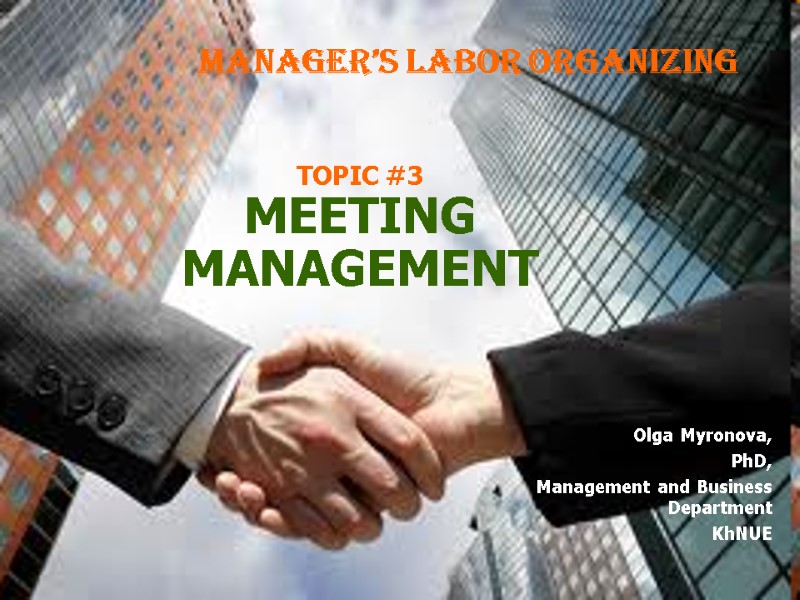
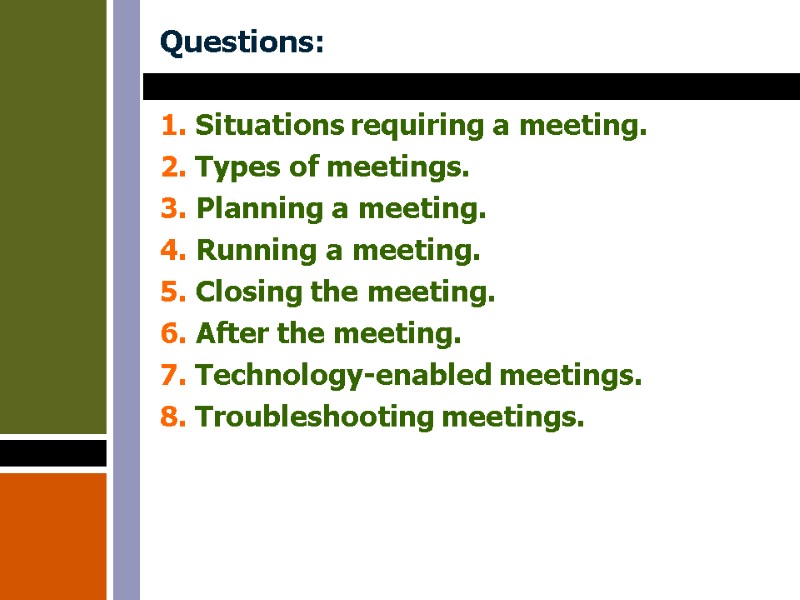
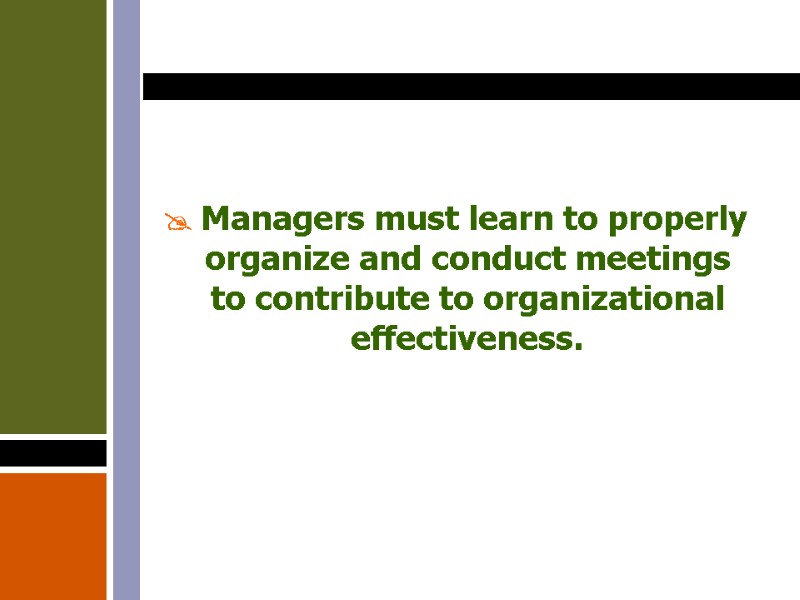
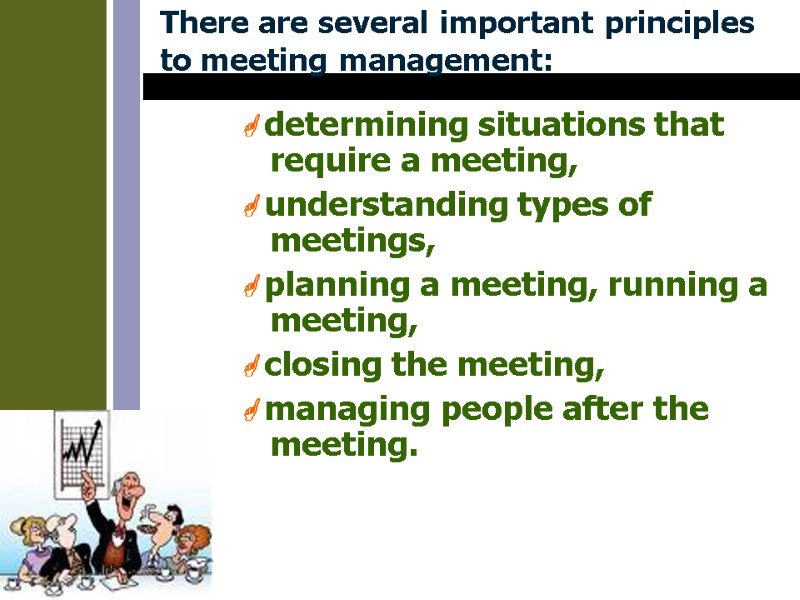
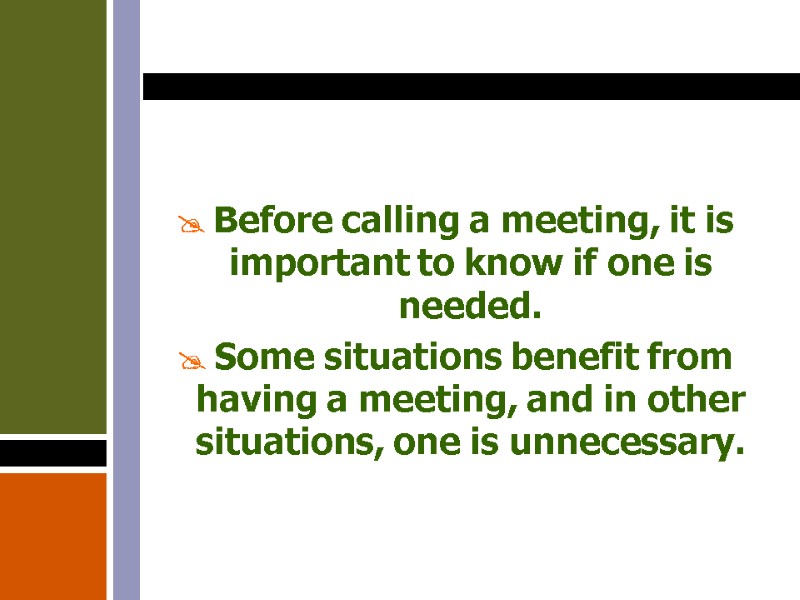
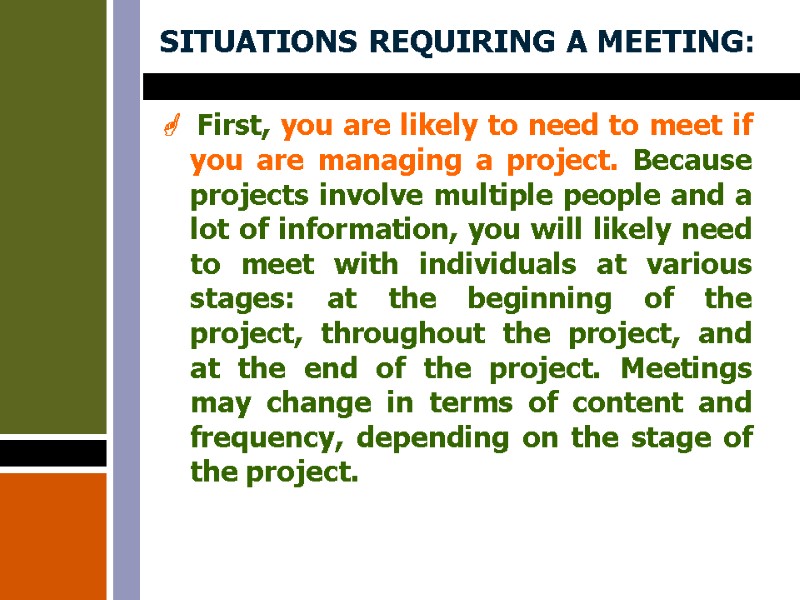
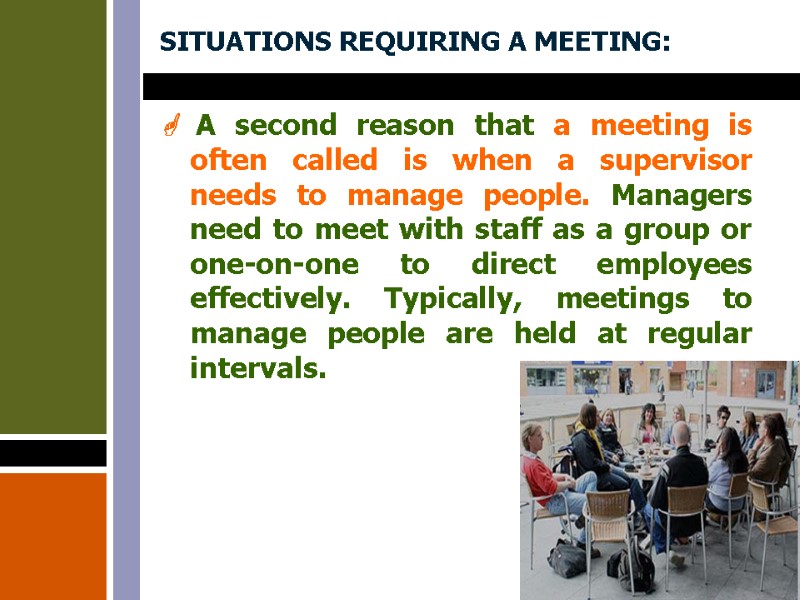
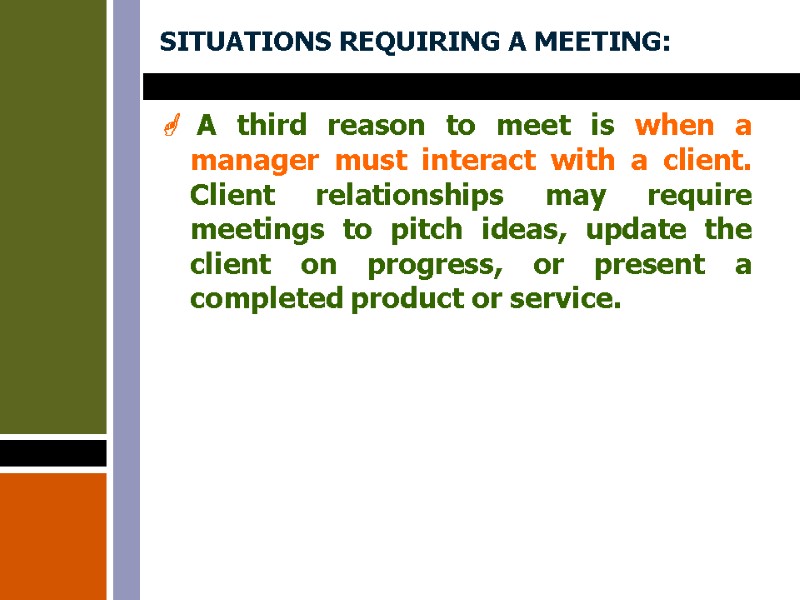
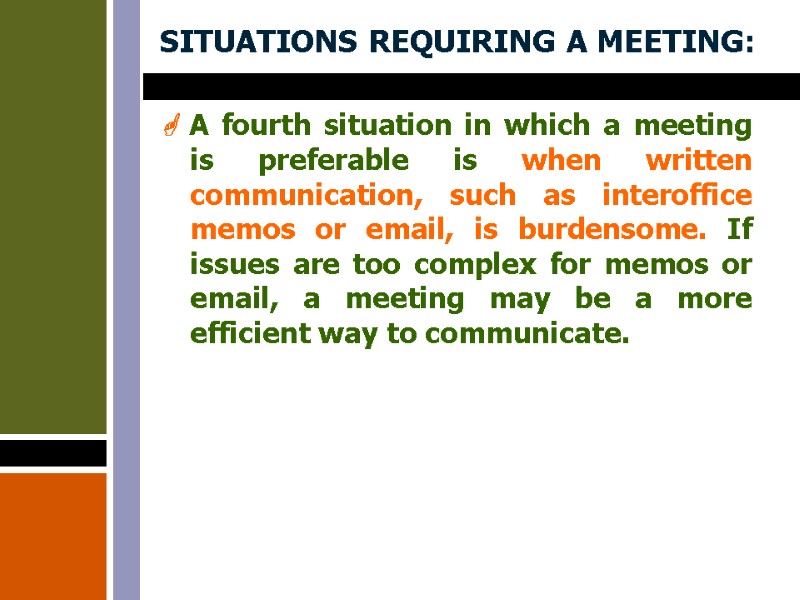
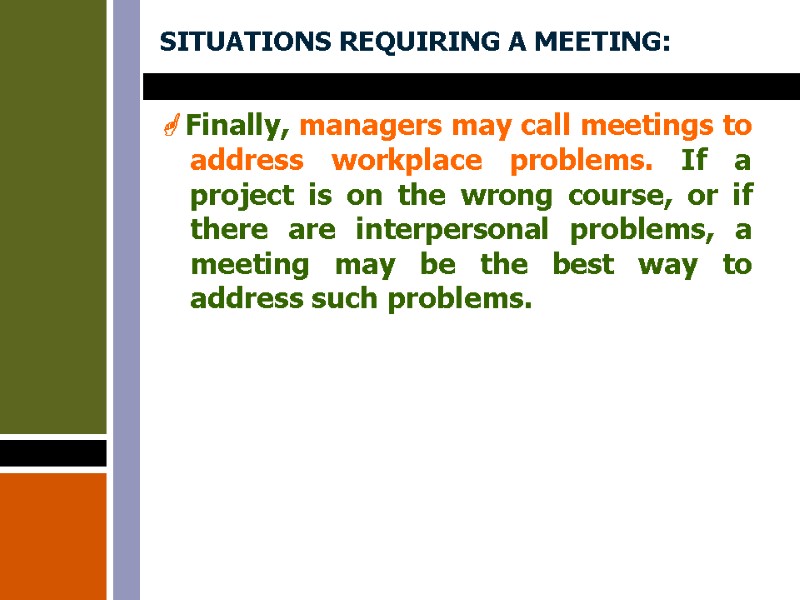
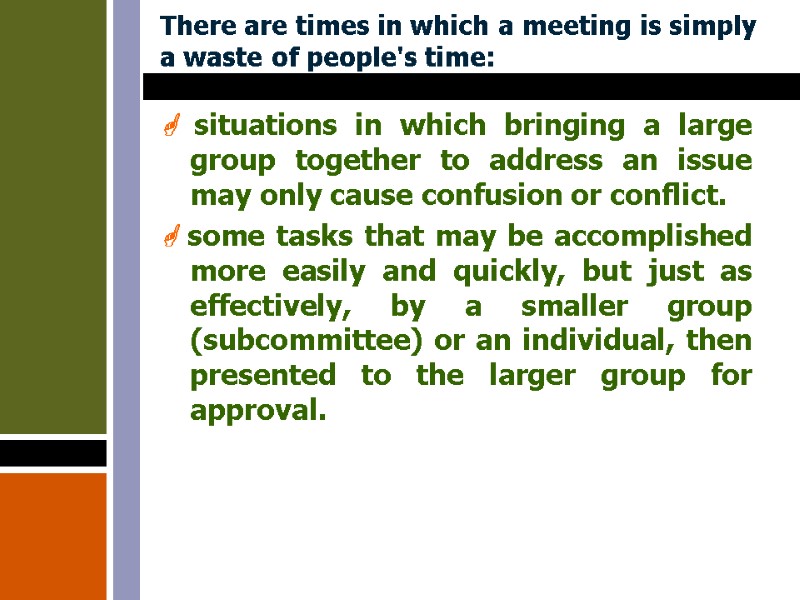
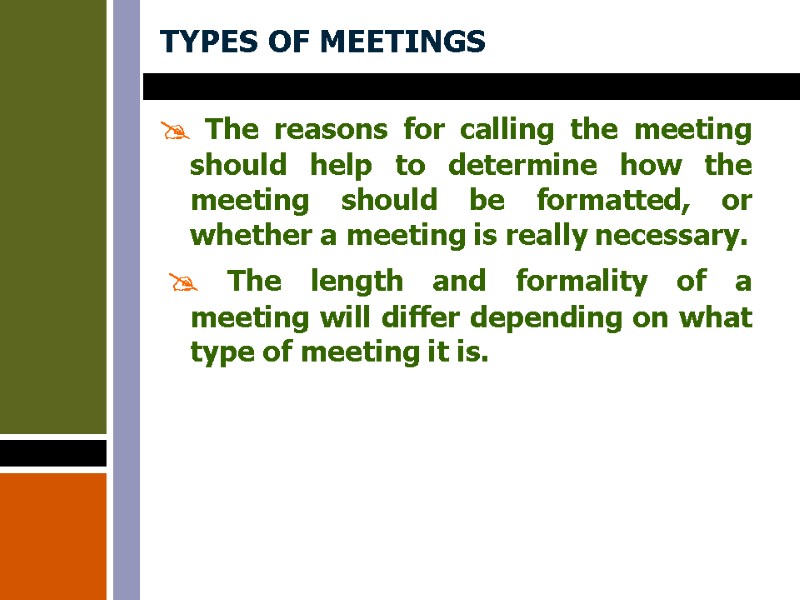

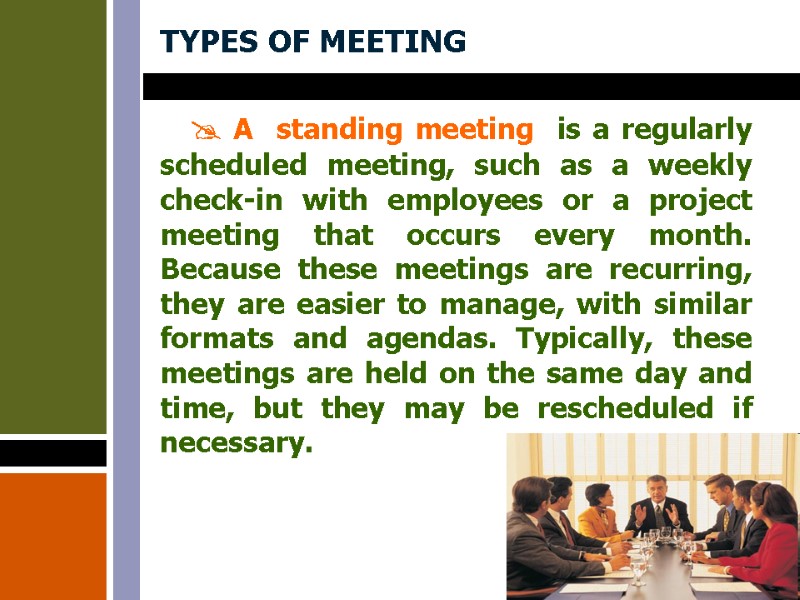
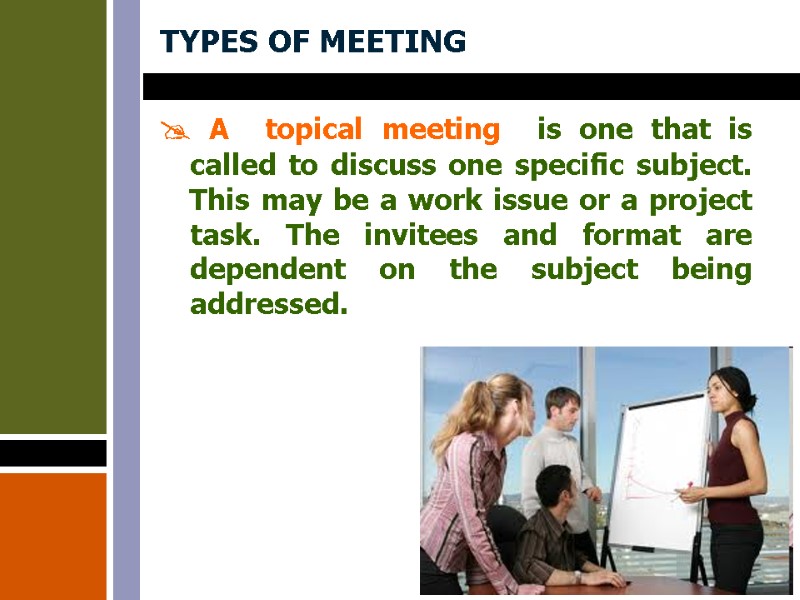
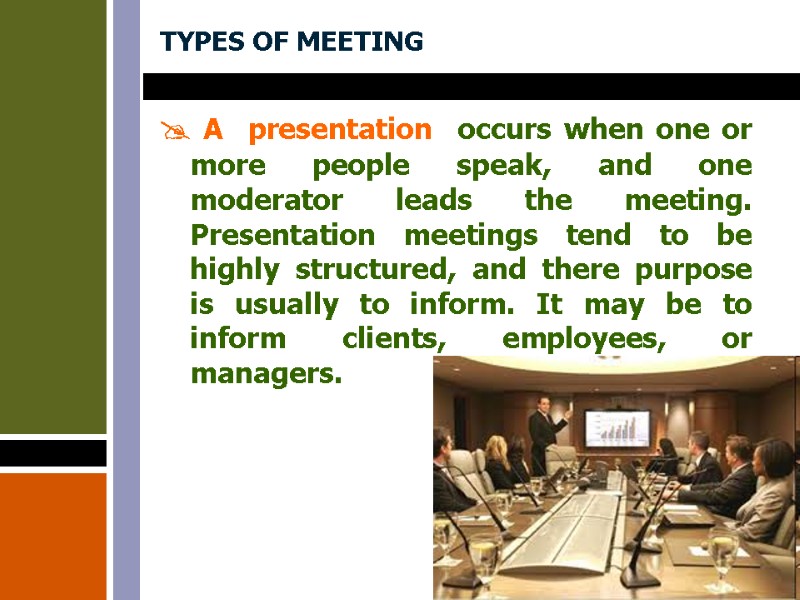
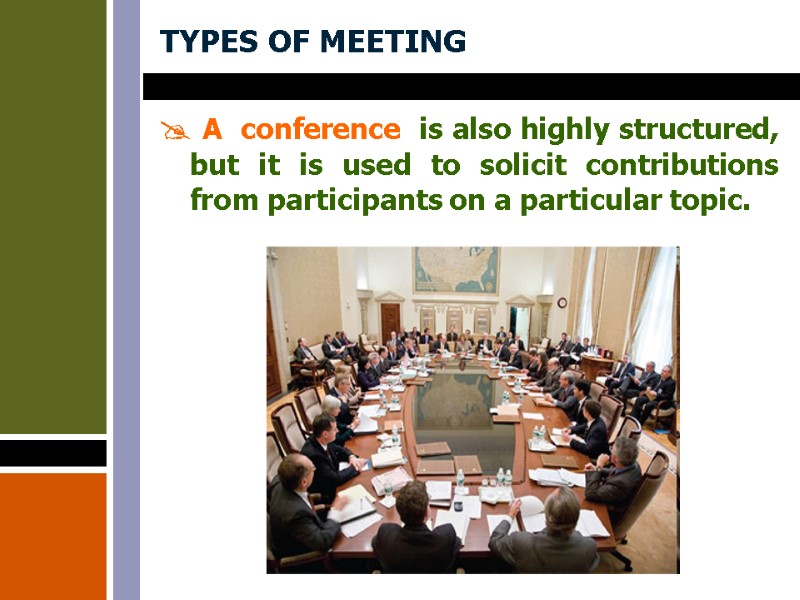
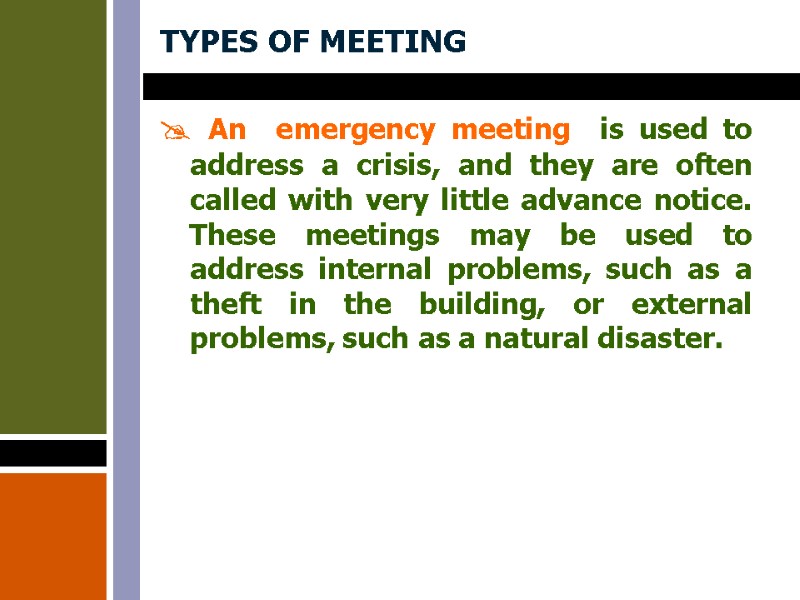
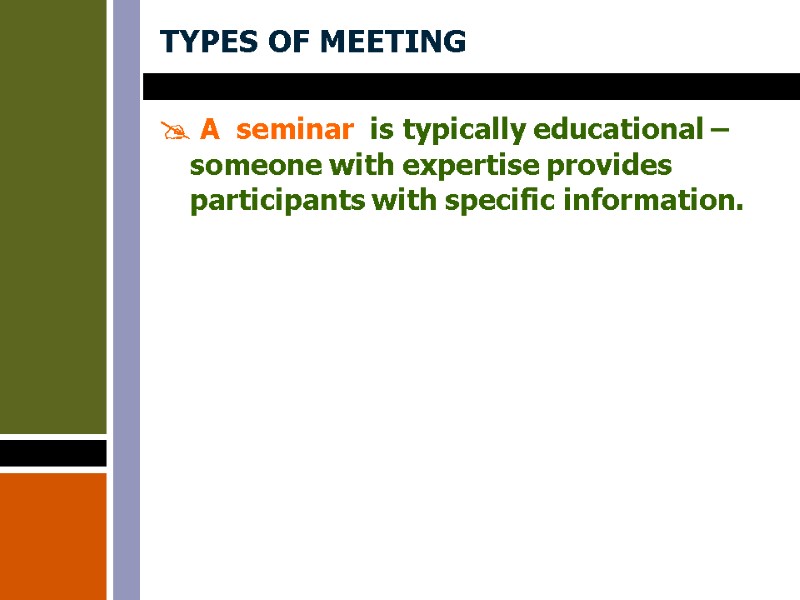
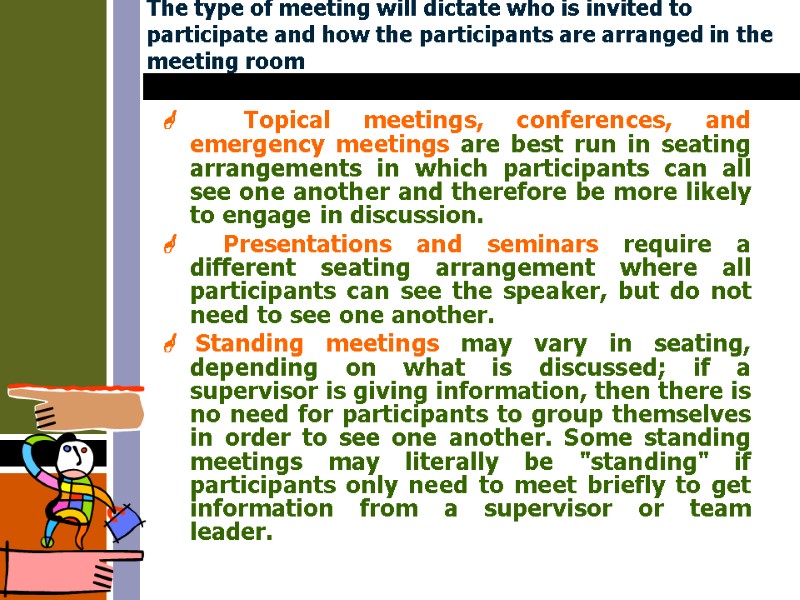
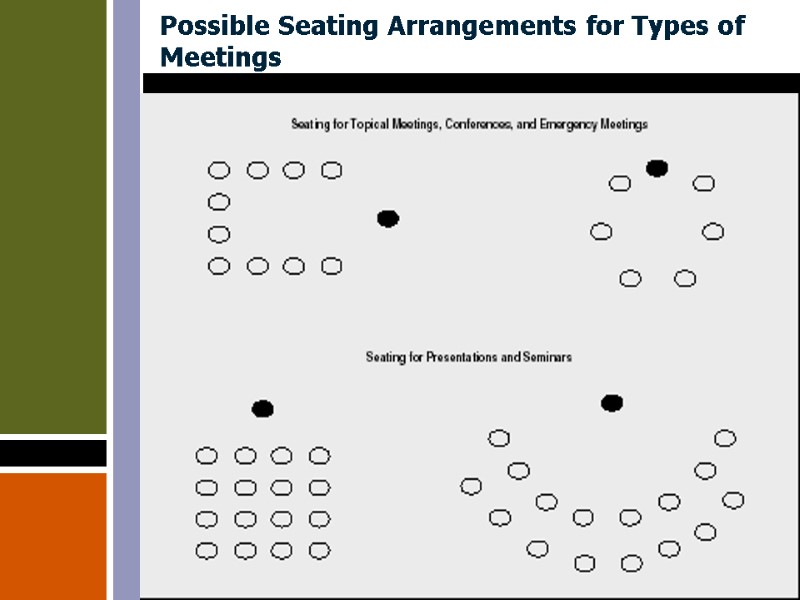
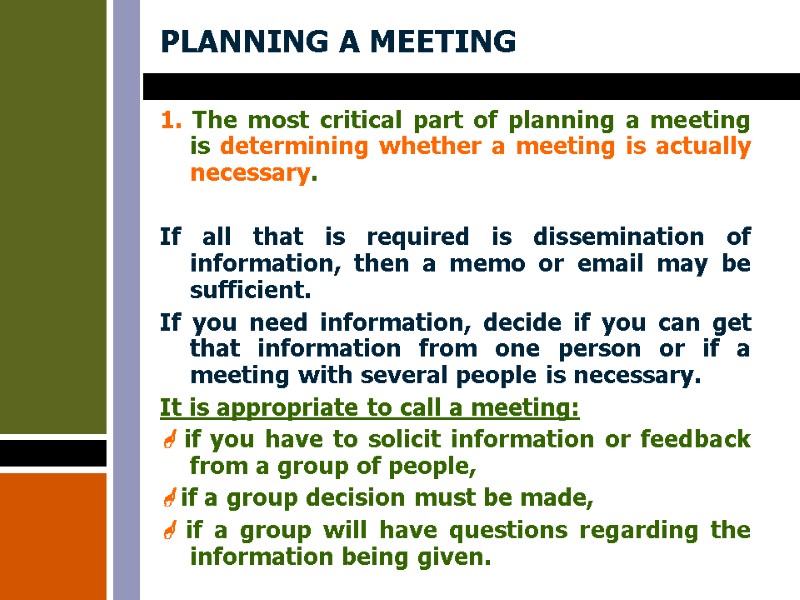
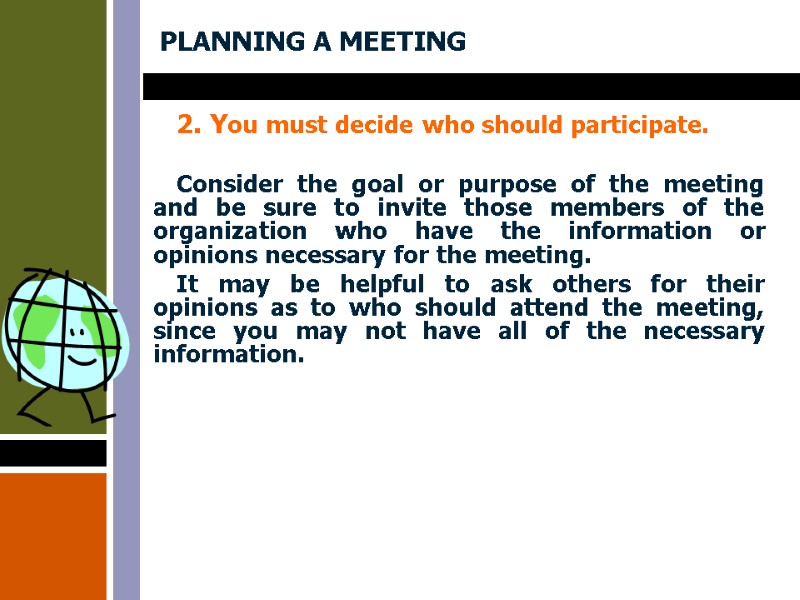
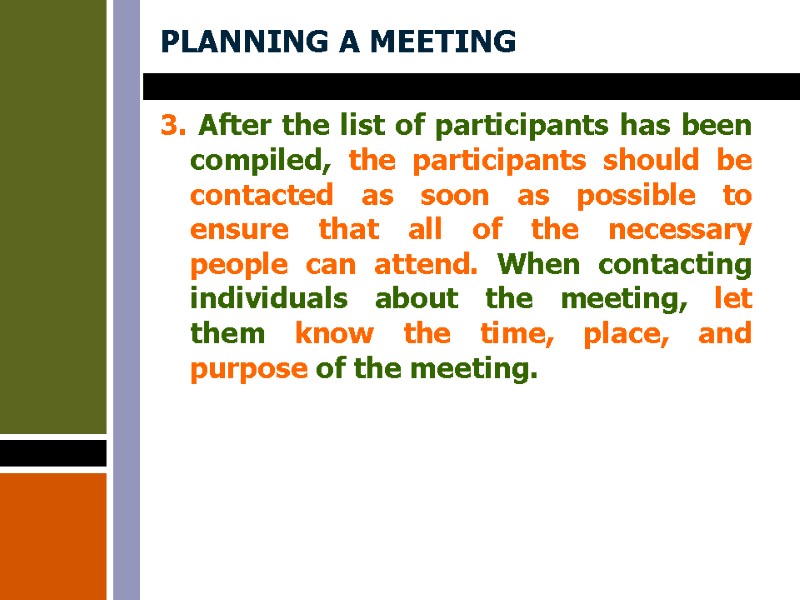
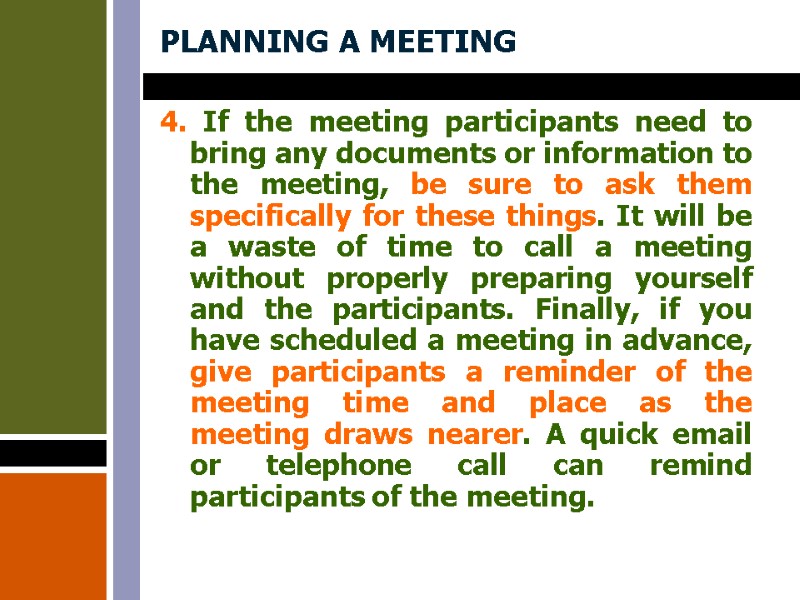
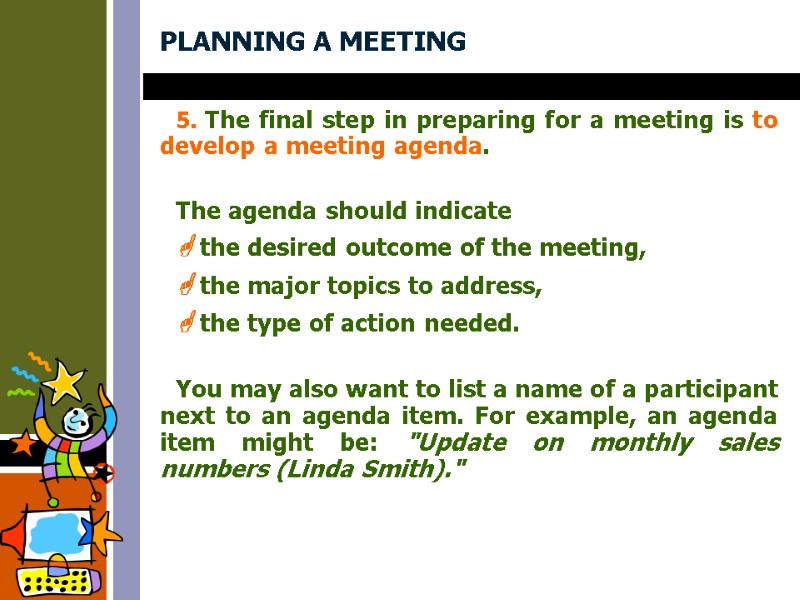
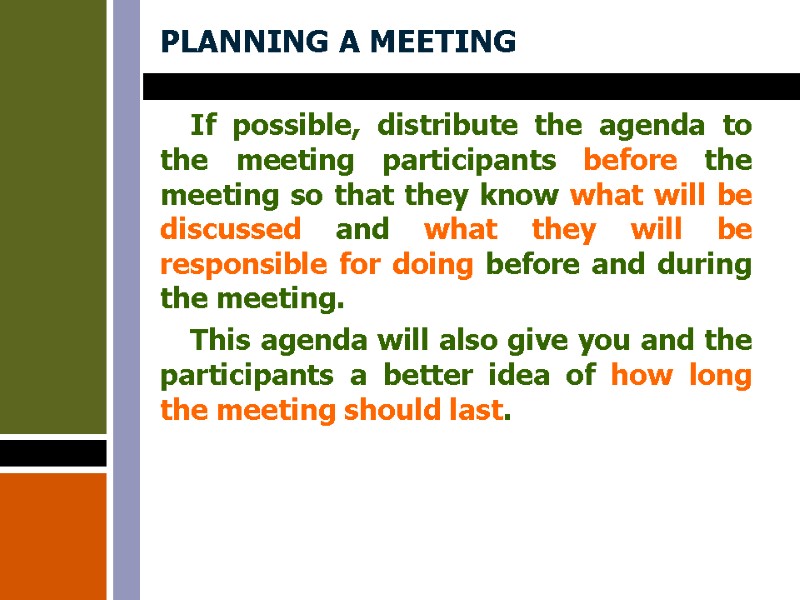
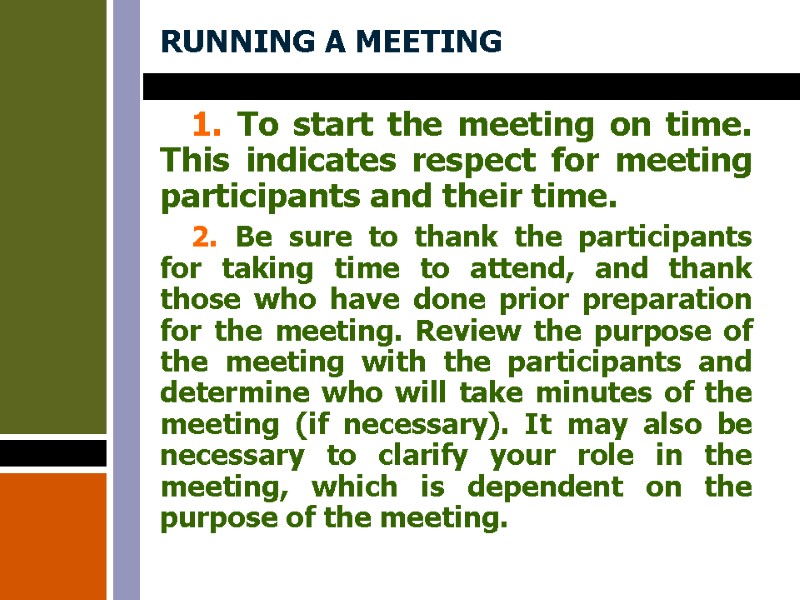
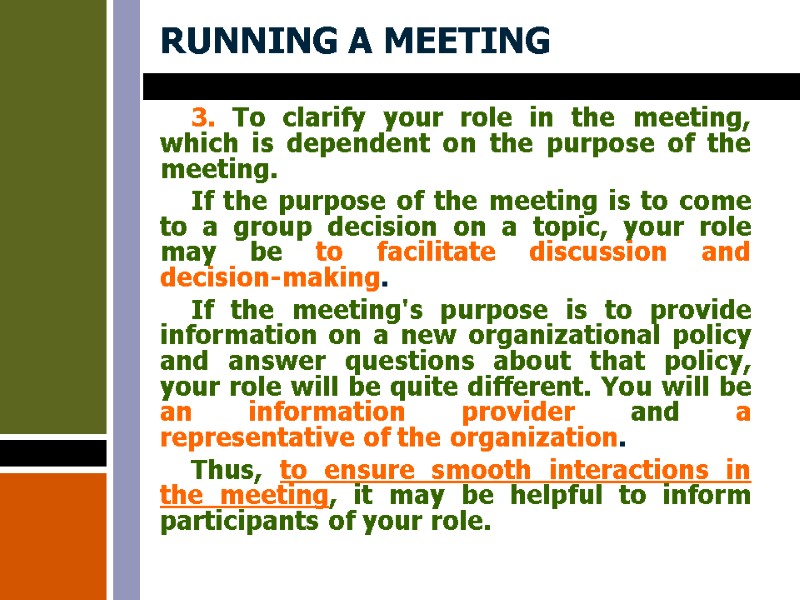
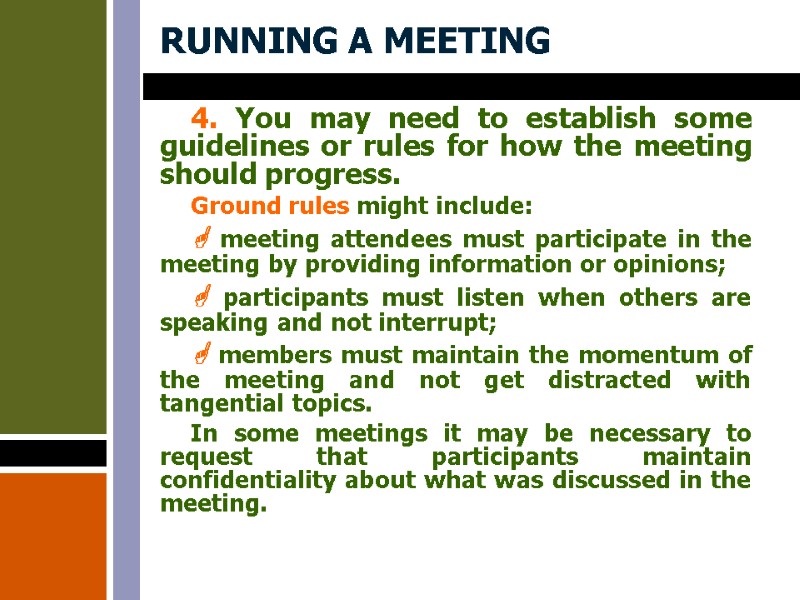
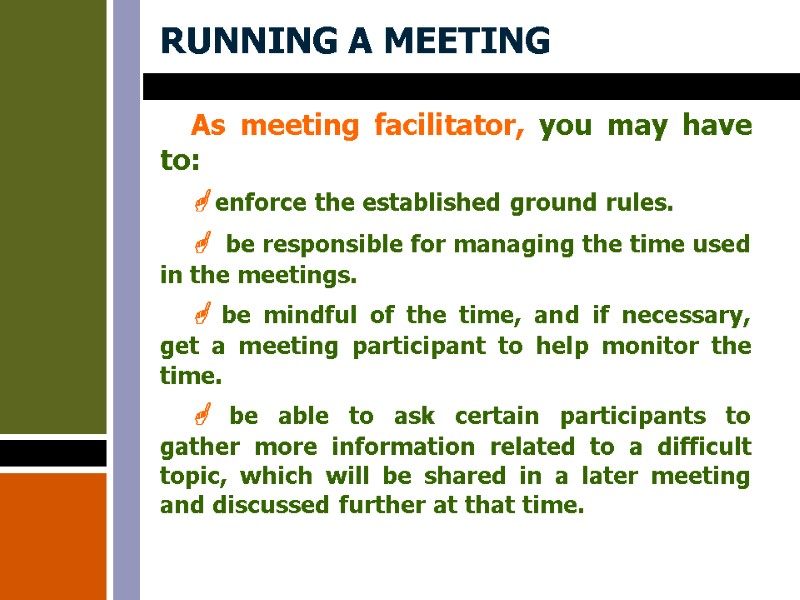
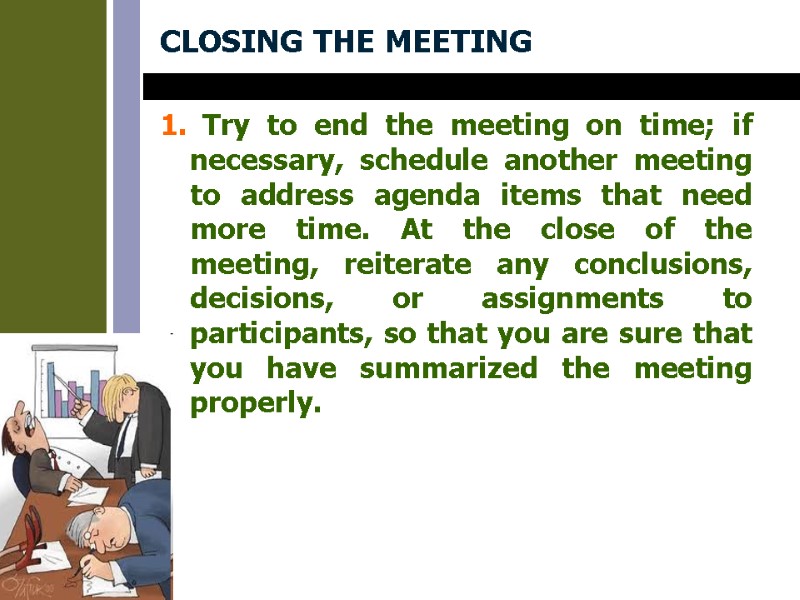
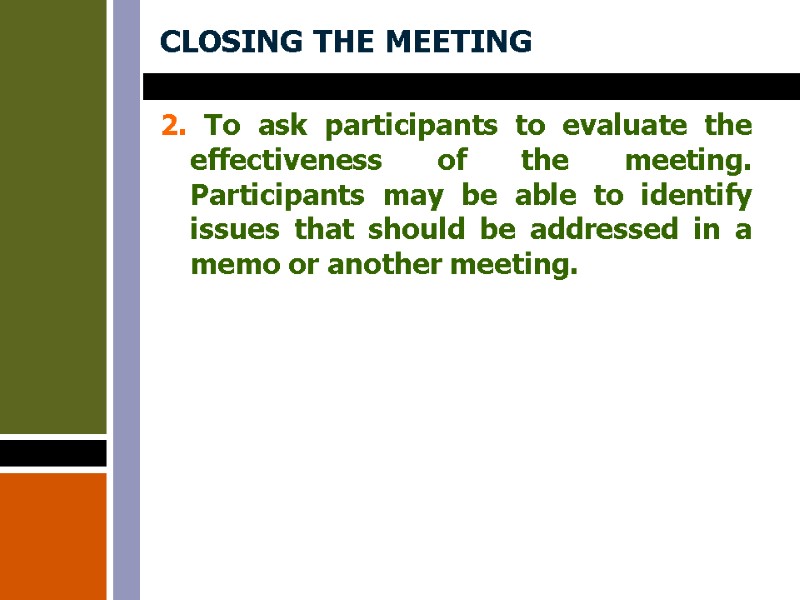
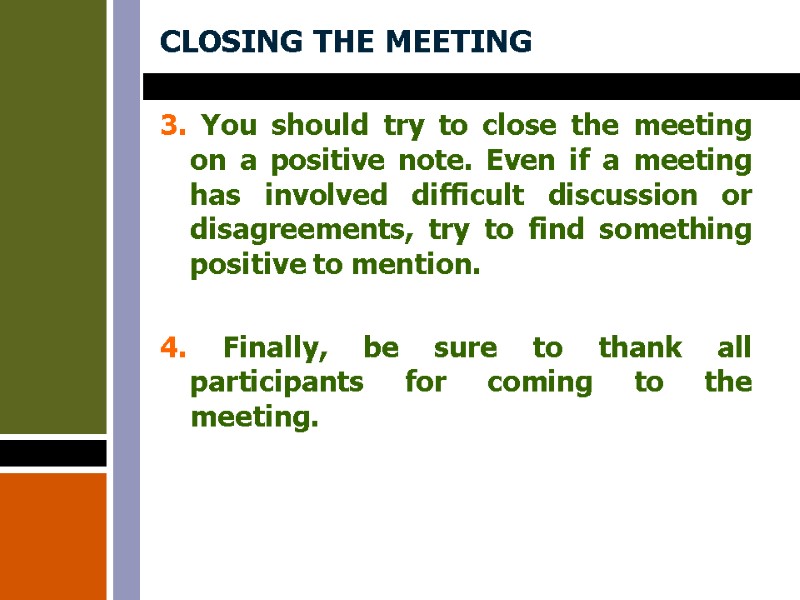
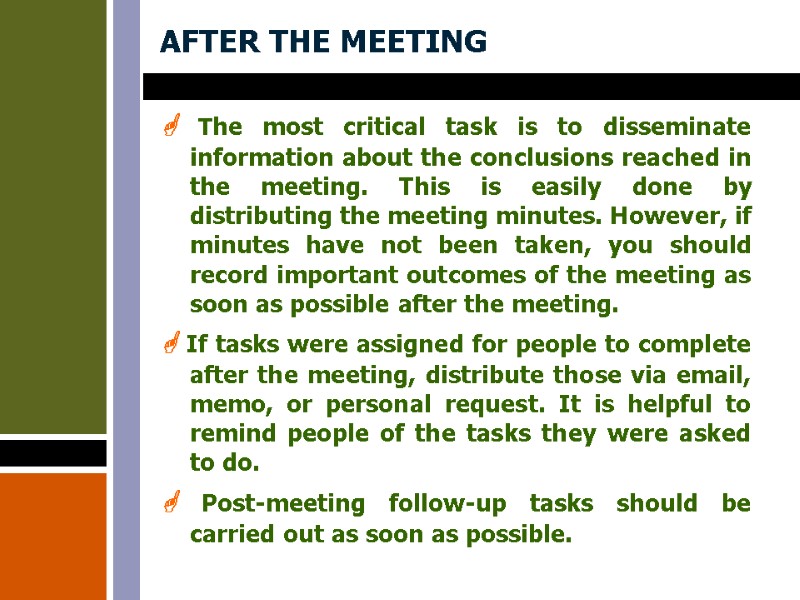
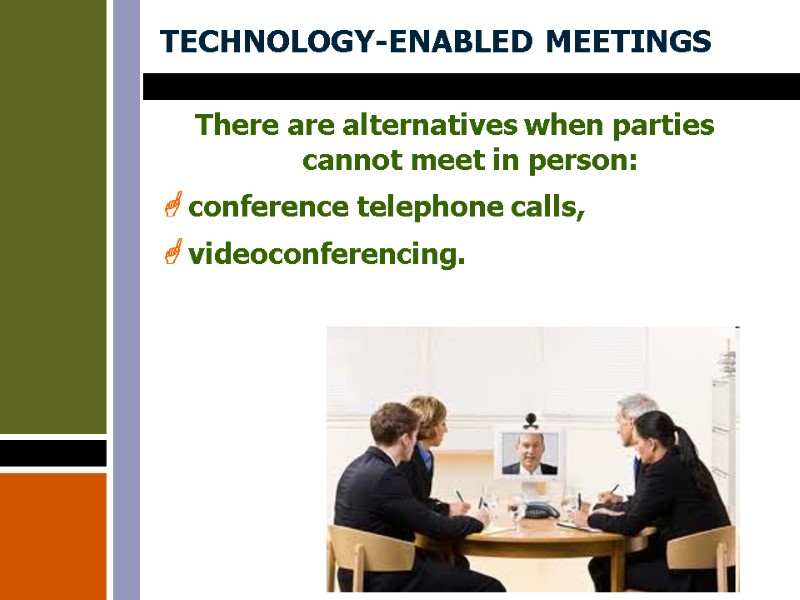
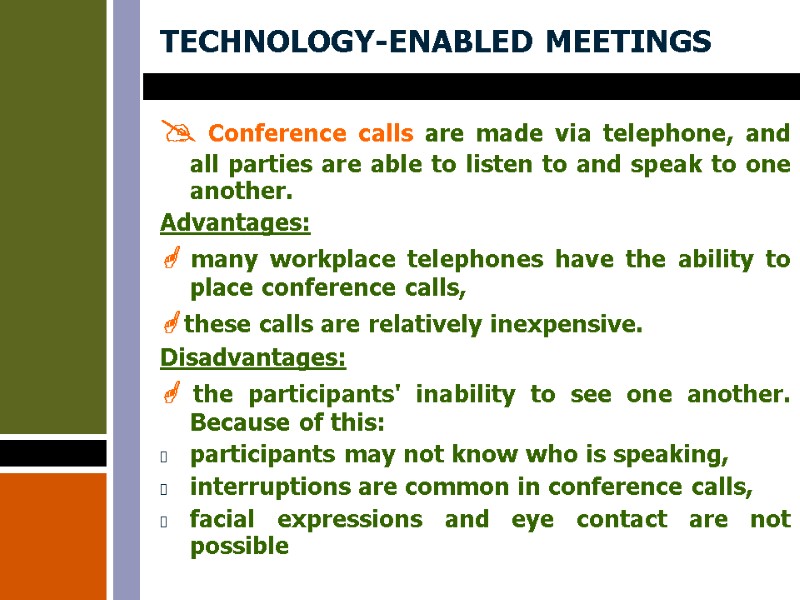
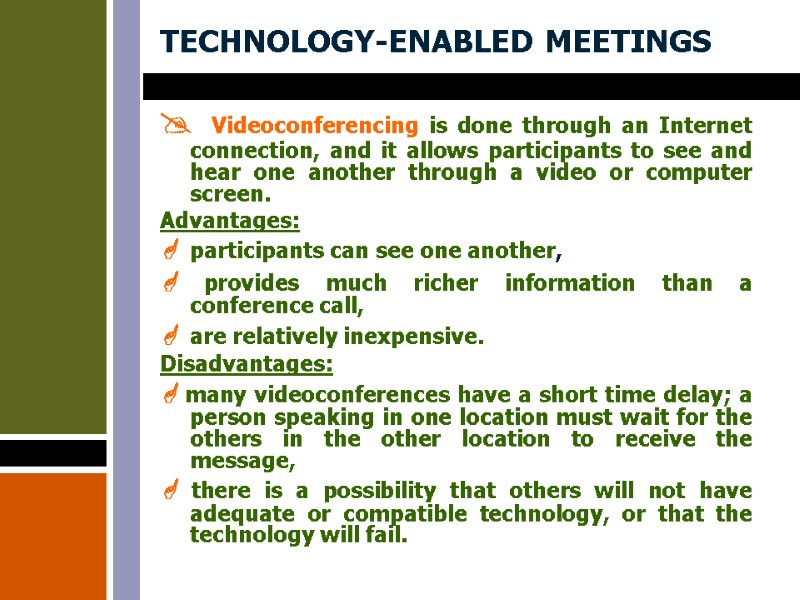
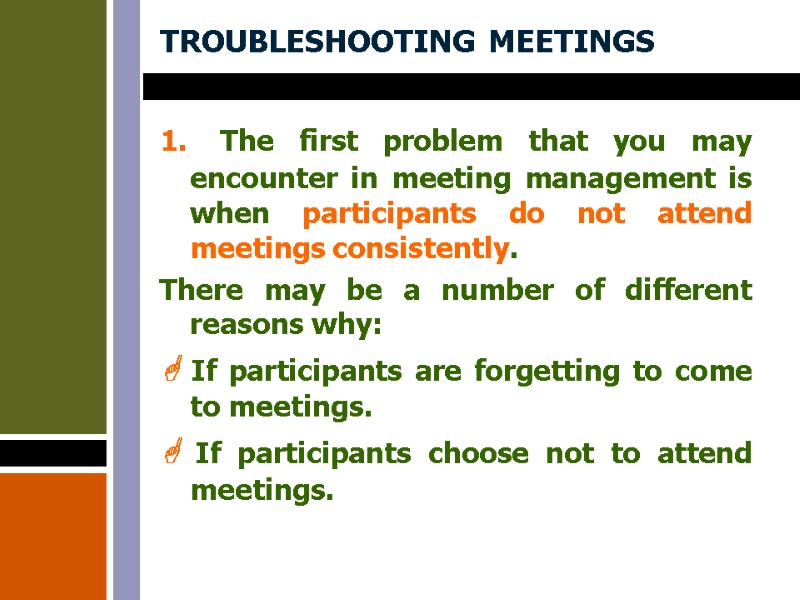
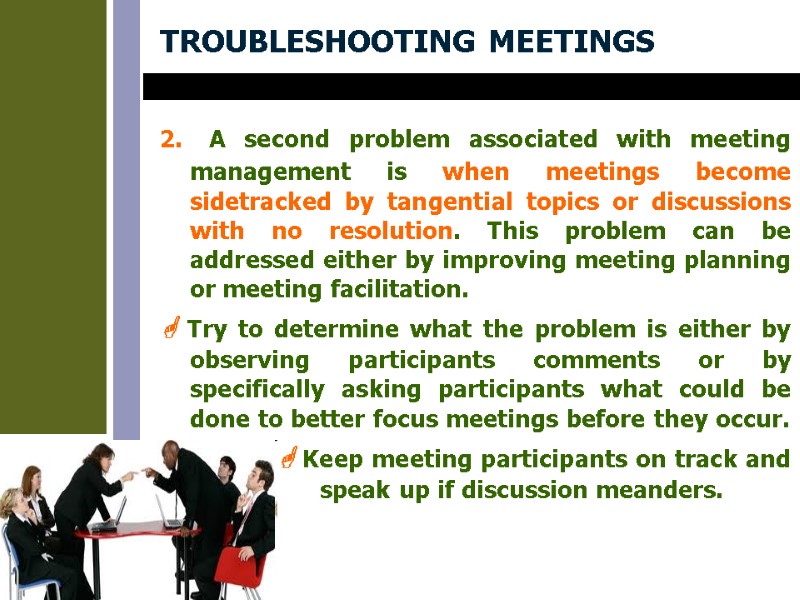
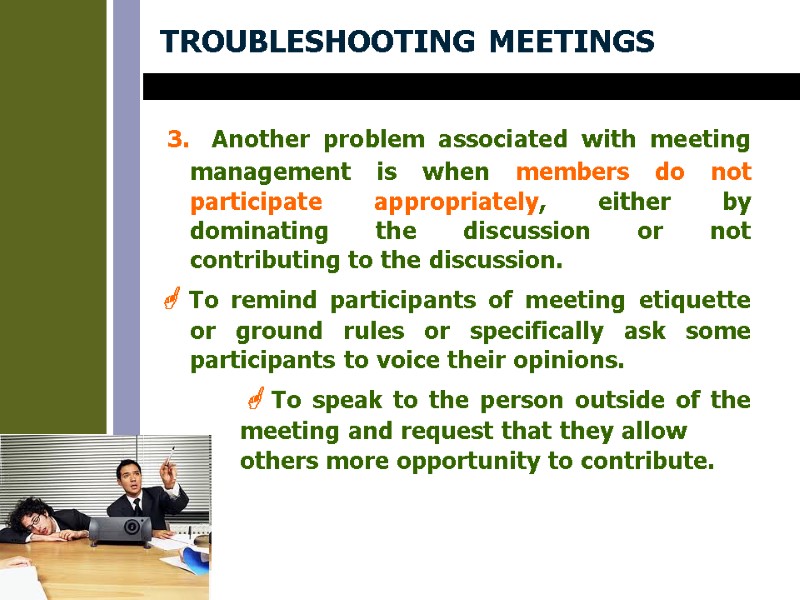
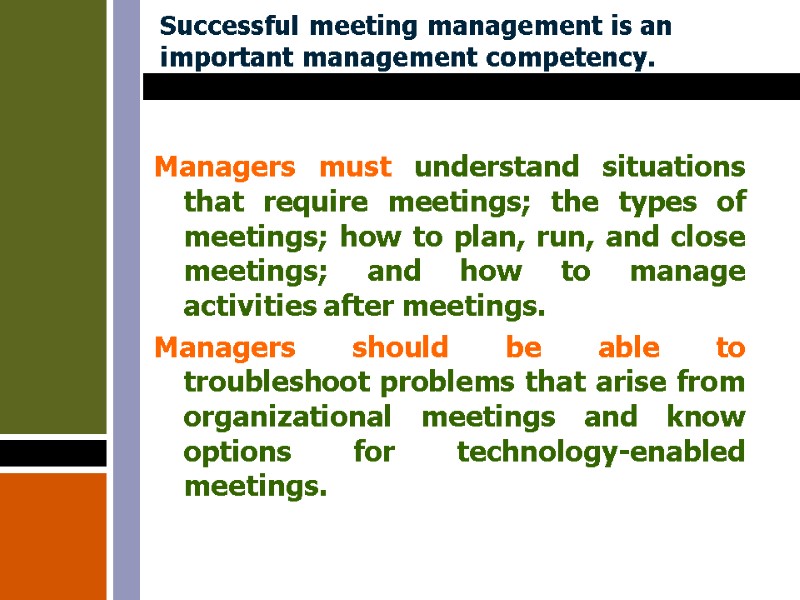
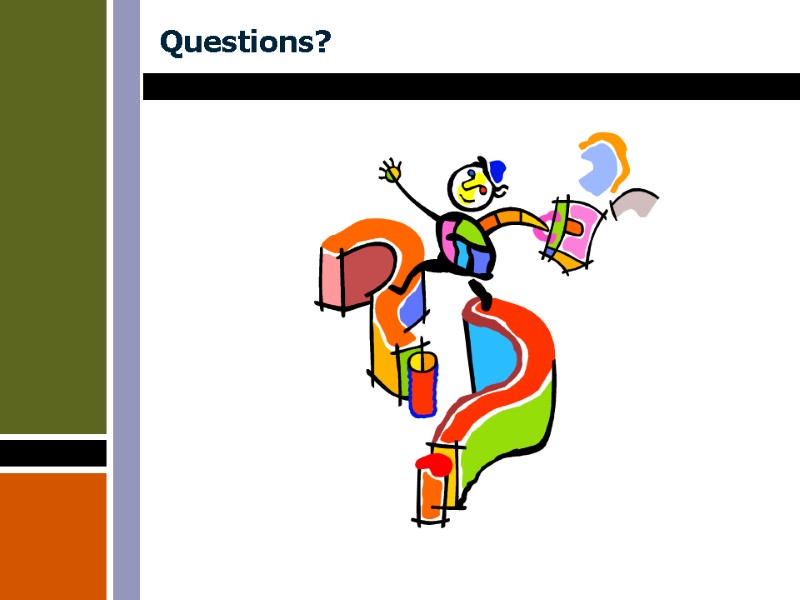
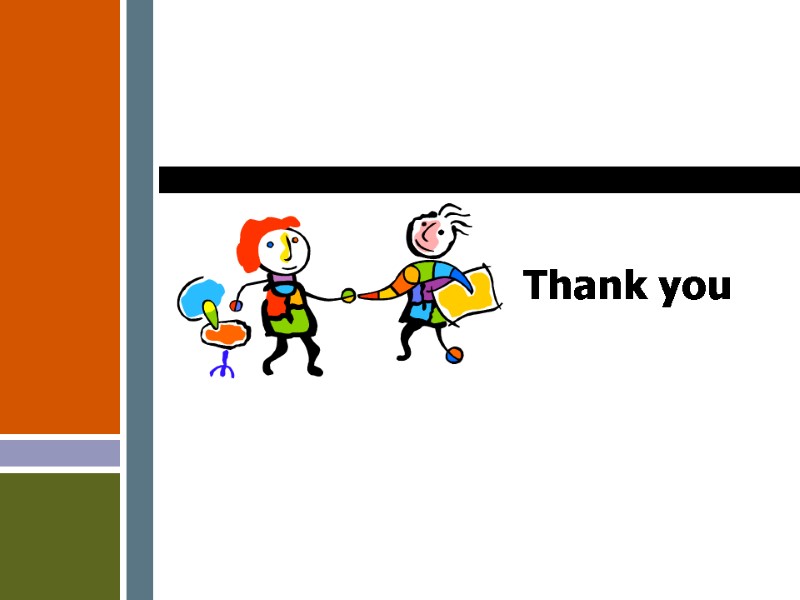
14324-topic_3.ppt
- Количество слайдов: 44
 TOPIC #3 MEETING MANAGEMENT Olga Myronova, PhD, Management and Business Department KhNUE MANAGER’S LABOR ORGANIZING
TOPIC #3 MEETING MANAGEMENT Olga Myronova, PhD, Management and Business Department KhNUE MANAGER’S LABOR ORGANIZING
 Questions: 1. Situations requiring a meeting. 2. Types of meetings. 3. Planning a meeting. 4. Running a meeting. 5. Closing the meeting. 6. After the meeting. 7. Technology-enabled meetings. 8. Troubleshooting meetings.
Questions: 1. Situations requiring a meeting. 2. Types of meetings. 3. Planning a meeting. 4. Running a meeting. 5. Closing the meeting. 6. After the meeting. 7. Technology-enabled meetings. 8. Troubleshooting meetings.
 Managers must learn to properly organize and conduct meetings to contribute to organizational effectiveness.
Managers must learn to properly organize and conduct meetings to contribute to organizational effectiveness.
 There are several important principles to meeting management: determining situations that require a meeting, understanding types of meetings, planning a meeting, running a meeting, closing the meeting, managing people after the meeting.
There are several important principles to meeting management: determining situations that require a meeting, understanding types of meetings, planning a meeting, running a meeting, closing the meeting, managing people after the meeting.
 Before calling a meeting, it is important to know if one is needed. Some situations benefit from having a meeting, and in other situations, one is unnecessary.
Before calling a meeting, it is important to know if one is needed. Some situations benefit from having a meeting, and in other situations, one is unnecessary.
 SITUATIONS REQUIRING A MEETING: First, you are likely to need to meet if you are managing a project. Because projects involve multiple people and a lot of information, you will likely need to meet with individuals at various stages: at the beginning of the project, throughout the project, and at the end of the project. Meetings may change in terms of content and frequency, depending on the stage of the project.
SITUATIONS REQUIRING A MEETING: First, you are likely to need to meet if you are managing a project. Because projects involve multiple people and a lot of information, you will likely need to meet with individuals at various stages: at the beginning of the project, throughout the project, and at the end of the project. Meetings may change in terms of content and frequency, depending on the stage of the project.
 SITUATIONS REQUIRING A MEETING: A second reason that a meeting is often called is when a supervisor needs to manage people. Managers need to meet with staff as a group or one-on-one to direct employees effectively. Typically, meetings to manage people are held at regular intervals.
SITUATIONS REQUIRING A MEETING: A second reason that a meeting is often called is when a supervisor needs to manage people. Managers need to meet with staff as a group or one-on-one to direct employees effectively. Typically, meetings to manage people are held at regular intervals.
 SITUATIONS REQUIRING A MEETING: A third reason to meet is when a manager must interact with a client. Client relationships may require meetings to pitch ideas, update the client on progress, or present a completed product or service.
SITUATIONS REQUIRING A MEETING: A third reason to meet is when a manager must interact with a client. Client relationships may require meetings to pitch ideas, update the client on progress, or present a completed product or service.
 SITUATIONS REQUIRING A MEETING: A fourth situation in which a meeting is preferable is when written communication, such as interoffice memos or email, is burdensome. If issues are too complex for memos or email, a meeting may be a more efficient way to communicate.
SITUATIONS REQUIRING A MEETING: A fourth situation in which a meeting is preferable is when written communication, such as interoffice memos or email, is burdensome. If issues are too complex for memos or email, a meeting may be a more efficient way to communicate.
 SITUATIONS REQUIRING A MEETING: Finally, managers may call meetings to address workplace problems. If a project is on the wrong course, or if there are interpersonal problems, a meeting may be the best way to address such problems.
SITUATIONS REQUIRING A MEETING: Finally, managers may call meetings to address workplace problems. If a project is on the wrong course, or if there are interpersonal problems, a meeting may be the best way to address such problems.
 There are times in which a meeting is simply a waste of people's time: situations in which bringing a large group together to address an issue may only cause confusion or conflict. some tasks that may be accomplished more easily and quickly, but just as effectively, by a smaller group (subcommittee) or an individual, then presented to the larger group for approval.
There are times in which a meeting is simply a waste of people's time: situations in which bringing a large group together to address an issue may only cause confusion or conflict. some tasks that may be accomplished more easily and quickly, but just as effectively, by a smaller group (subcommittee) or an individual, then presented to the larger group for approval.
 TYPES OF MEETINGS The reasons for calling the meeting should help to determine how the meeting should be formatted, or whether a meeting is really necessary. The length and formality of a meeting will differ depending on what type of meeting it is.
TYPES OF MEETINGS The reasons for calling the meeting should help to determine how the meeting should be formatted, or whether a meeting is really necessary. The length and formality of a meeting will differ depending on what type of meeting it is.
 There are six basic types of meeting: standing meeting, topical meeting, presentation, conference, emergency meeting, seminar.
There are six basic types of meeting: standing meeting, topical meeting, presentation, conference, emergency meeting, seminar.
 TYPES OF MEETING A standing meeting is a regularly scheduled meeting, such as a weekly check-in with employees or a project meeting that occurs every month. Because these meetings are recurring, they are easier to manage, with similar formats and agendas. Typically, these meetings are held on the same day and time, but they may be rescheduled if necessary.
TYPES OF MEETING A standing meeting is a regularly scheduled meeting, such as a weekly check-in with employees or a project meeting that occurs every month. Because these meetings are recurring, they are easier to manage, with similar formats and agendas. Typically, these meetings are held on the same day and time, but they may be rescheduled if necessary.
 TYPES OF MEETING A topical meeting is one that is called to discuss one specific subject. This may be a work issue or a project task. The invitees and format are dependent on the subject being addressed.
TYPES OF MEETING A topical meeting is one that is called to discuss one specific subject. This may be a work issue or a project task. The invitees and format are dependent on the subject being addressed.
 TYPES OF MEETING A presentation occurs when one or more people speak, and one moderator leads the meeting. Presentation meetings tend to be highly structured, and there purpose is usually to inform. It may be to inform clients, employees, or managers.
TYPES OF MEETING A presentation occurs when one or more people speak, and one moderator leads the meeting. Presentation meetings tend to be highly structured, and there purpose is usually to inform. It may be to inform clients, employees, or managers.
 TYPES OF MEETING A conference is also highly structured, but it is used to solicit contributions from participants on a particular topic.
TYPES OF MEETING A conference is also highly structured, but it is used to solicit contributions from participants on a particular topic.
 TYPES OF MEETING An emergency meeting is used to address a crisis, and they are often called with very little advance notice. These meetings may be used to address internal problems, such as a theft in the building, or external problems, such as a natural disaster.
TYPES OF MEETING An emergency meeting is used to address a crisis, and they are often called with very little advance notice. These meetings may be used to address internal problems, such as a theft in the building, or external problems, such as a natural disaster.
 TYPES OF MEETING A seminar is typically educational –someone with expertise provides participants with specific information.
TYPES OF MEETING A seminar is typically educational –someone with expertise provides participants with specific information.
 The type of meeting will dictate who is invited to participate and how the participants are arranged in the meeting room Topical meetings, conferences, and emergency meetings are best run in seating arrangements in which participants can all see one another and therefore be more likely to engage in discussion. Presentations and seminars require a different seating arrangement where all participants can see the speaker, but do not need to see one another. Standing meetings may vary in seating, depending on what is discussed; if a supervisor is giving information, then there is no need for participants to group themselves in order to see one another. Some standing meetings may literally be "standing" if participants only need to meet briefly to get information from a supervisor or team leader.
The type of meeting will dictate who is invited to participate and how the participants are arranged in the meeting room Topical meetings, conferences, and emergency meetings are best run in seating arrangements in which participants can all see one another and therefore be more likely to engage in discussion. Presentations and seminars require a different seating arrangement where all participants can see the speaker, but do not need to see one another. Standing meetings may vary in seating, depending on what is discussed; if a supervisor is giving information, then there is no need for participants to group themselves in order to see one another. Some standing meetings may literally be "standing" if participants only need to meet briefly to get information from a supervisor or team leader.
 Possible Seating Arrangements for Types of Meetings
Possible Seating Arrangements for Types of Meetings
 PLANNING A MEETING 1. The most critical part of planning a meeting is determining whether a meeting is actually necessary. If all that is required is dissemination of information, then a memo or email may be sufficient. If you need information, decide if you can get that information from one person or if a meeting with several people is necessary. It is appropriate to call a meeting: if you have to solicit information or feedback from a group of people, if a group decision must be made, if a group will have questions regarding the information being given.
PLANNING A MEETING 1. The most critical part of planning a meeting is determining whether a meeting is actually necessary. If all that is required is dissemination of information, then a memo or email may be sufficient. If you need information, decide if you can get that information from one person or if a meeting with several people is necessary. It is appropriate to call a meeting: if you have to solicit information or feedback from a group of people, if a group decision must be made, if a group will have questions regarding the information being given.
 PLANNING A MEETING 2. You must decide who should participate. Consider the goal or purpose of the meeting and be sure to invite those members of the organization who have the information or opinions necessary for the meeting. It may be helpful to ask others for their opinions as to who should attend the meeting, since you may not have all of the necessary information.
PLANNING A MEETING 2. You must decide who should participate. Consider the goal or purpose of the meeting and be sure to invite those members of the organization who have the information or opinions necessary for the meeting. It may be helpful to ask others for their opinions as to who should attend the meeting, since you may not have all of the necessary information.
 PLANNING A MEETING 3. After the list of participants has been compiled, the participants should be contacted as soon as possible to ensure that all of the necessary people can attend. When contacting individuals about the meeting, let them know the time, place, and purpose of the meeting.
PLANNING A MEETING 3. After the list of participants has been compiled, the participants should be contacted as soon as possible to ensure that all of the necessary people can attend. When contacting individuals about the meeting, let them know the time, place, and purpose of the meeting.
 PLANNING A MEETING 4. If the meeting participants need to bring any documents or information to the meeting, be sure to ask them specifically for these things. It will be a waste of time to call a meeting without properly preparing yourself and the participants. Finally, if you have scheduled a meeting in advance, give participants a reminder of the meeting time and place as the meeting draws nearer. A quick email or telephone call can remind participants of the meeting.
PLANNING A MEETING 4. If the meeting participants need to bring any documents or information to the meeting, be sure to ask them specifically for these things. It will be a waste of time to call a meeting without properly preparing yourself and the participants. Finally, if you have scheduled a meeting in advance, give participants a reminder of the meeting time and place as the meeting draws nearer. A quick email or telephone call can remind participants of the meeting.
 PLANNING A MEETING 5. The final step in preparing for a meeting is to develop a meeting agenda. The agenda should indicate the desired outcome of the meeting, the major topics to address, the type of action needed. You may also want to list a name of a participant next to an agenda item. For example, an agenda item might be: "Update on monthly sales numbers (Linda Smith)."
PLANNING A MEETING 5. The final step in preparing for a meeting is to develop a meeting agenda. The agenda should indicate the desired outcome of the meeting, the major topics to address, the type of action needed. You may also want to list a name of a participant next to an agenda item. For example, an agenda item might be: "Update on monthly sales numbers (Linda Smith)."
 PLANNING A MEETING If possible, distribute the agenda to the meeting participants before the meeting so that they know what will be discussed and what they will be responsible for doing before and during the meeting. This agenda will also give you and the participants a better idea of how long the meeting should last.
PLANNING A MEETING If possible, distribute the agenda to the meeting participants before the meeting so that they know what will be discussed and what they will be responsible for doing before and during the meeting. This agenda will also give you and the participants a better idea of how long the meeting should last.
 RUNNING A MEETING 1. To start the meeting on time. This indicates respect for meeting participants and their time. 2. Be sure to thank the participants for taking time to attend, and thank those who have done prior preparation for the meeting. Review the purpose of the meeting with the participants and determine who will take minutes of the meeting (if necessary). It may also be necessary to clarify your role in the meeting, which is dependent on the purpose of the meeting.
RUNNING A MEETING 1. To start the meeting on time. This indicates respect for meeting participants and their time. 2. Be sure to thank the participants for taking time to attend, and thank those who have done prior preparation for the meeting. Review the purpose of the meeting with the participants and determine who will take minutes of the meeting (if necessary). It may also be necessary to clarify your role in the meeting, which is dependent on the purpose of the meeting.
 RUNNING A MEETING 3. To clarify your role in the meeting, which is dependent on the purpose of the meeting. If the purpose of the meeting is to come to a group decision on a topic, your role may be to facilitate discussion and decision-making. If the meeting's purpose is to provide information on a new organizational policy and answer questions about that policy, your role will be quite different. You will be an information provider and a representative of the organization. Thus, to ensure smooth interactions in the meeting, it may be helpful to inform participants of your role.
RUNNING A MEETING 3. To clarify your role in the meeting, which is dependent on the purpose of the meeting. If the purpose of the meeting is to come to a group decision on a topic, your role may be to facilitate discussion and decision-making. If the meeting's purpose is to provide information on a new organizational policy and answer questions about that policy, your role will be quite different. You will be an information provider and a representative of the organization. Thus, to ensure smooth interactions in the meeting, it may be helpful to inform participants of your role.
 RUNNING A MEETING 4. You may need to establish some guidelines or rules for how the meeting should progress. Ground rules might include: meeting attendees must participate in the meeting by providing information or opinions; participants must listen when others are speaking and not interrupt; members must maintain the momentum of the meeting and not get distracted with tangential topics. In some meetings it may be necessary to request that participants maintain confidentiality about what was discussed in the meeting.
RUNNING A MEETING 4. You may need to establish some guidelines or rules for how the meeting should progress. Ground rules might include: meeting attendees must participate in the meeting by providing information or opinions; participants must listen when others are speaking and not interrupt; members must maintain the momentum of the meeting and not get distracted with tangential topics. In some meetings it may be necessary to request that participants maintain confidentiality about what was discussed in the meeting.
 RUNNING A MEETING As meeting facilitator, you may have to: enforce the established ground rules. be responsible for managing the time used in the meetings. be mindful of the time, and if necessary, get a meeting participant to help monitor the time. be able to ask certain participants to gather more information related to a difficult topic, which will be shared in a later meeting and discussed further at that time.
RUNNING A MEETING As meeting facilitator, you may have to: enforce the established ground rules. be responsible for managing the time used in the meetings. be mindful of the time, and if necessary, get a meeting participant to help monitor the time. be able to ask certain participants to gather more information related to a difficult topic, which will be shared in a later meeting and discussed further at that time.
 CLOSING THE MEETING 1. Try to end the meeting on time; if necessary, schedule another meeting to address agenda items that need more time. At the close of the meeting, reiterate any conclusions, decisions, or assignments to participants, so that you are sure that you have summarized the meeting properly.
CLOSING THE MEETING 1. Try to end the meeting on time; if necessary, schedule another meeting to address agenda items that need more time. At the close of the meeting, reiterate any conclusions, decisions, or assignments to participants, so that you are sure that you have summarized the meeting properly.
 CLOSING THE MEETING 2. To ask participants to evaluate the effectiveness of the meeting. Participants may be able to identify issues that should be addressed in a memo or another meeting.
CLOSING THE MEETING 2. To ask participants to evaluate the effectiveness of the meeting. Participants may be able to identify issues that should be addressed in a memo or another meeting.
 CLOSING THE MEETING 3. You should try to close the meeting on a positive note. Even if a meeting has involved difficult discussion or disagreements, try to find something positive to mention. 4. Finally, be sure to thank all participants for coming to the meeting.
CLOSING THE MEETING 3. You should try to close the meeting on a positive note. Even if a meeting has involved difficult discussion or disagreements, try to find something positive to mention. 4. Finally, be sure to thank all participants for coming to the meeting.
 AFTER THE MEETING The most critical task is to disseminate information about the conclusions reached in the meeting. This is easily done by distributing the meeting minutes. However, if minutes have not been taken, you should record important outcomes of the meeting as soon as possible after the meeting. If tasks were assigned for people to complete after the meeting, distribute those via email, memo, or personal request. It is helpful to remind people of the tasks they were asked to do. Post-meeting follow-up tasks should be carried out as soon as possible.
AFTER THE MEETING The most critical task is to disseminate information about the conclusions reached in the meeting. This is easily done by distributing the meeting minutes. However, if minutes have not been taken, you should record important outcomes of the meeting as soon as possible after the meeting. If tasks were assigned for people to complete after the meeting, distribute those via email, memo, or personal request. It is helpful to remind people of the tasks they were asked to do. Post-meeting follow-up tasks should be carried out as soon as possible.
 TECHNOLOGY-ENABLED MEETINGS There are alternatives when parties cannot meet in person: conference telephone calls, videoconferencing.
TECHNOLOGY-ENABLED MEETINGS There are alternatives when parties cannot meet in person: conference telephone calls, videoconferencing.
 TECHNOLOGY-ENABLED MEETINGS Conference calls are made via telephone, and all parties are able to listen to and speak to one another. Advantages: many workplace telephones have the ability to place conference calls, these calls are relatively inexpensive. Disadvantages: the participants' inability to see one another. Because of this: participants may not know who is speaking, interruptions are common in conference calls, facial expressions and eye contact are not possible
TECHNOLOGY-ENABLED MEETINGS Conference calls are made via telephone, and all parties are able to listen to and speak to one another. Advantages: many workplace telephones have the ability to place conference calls, these calls are relatively inexpensive. Disadvantages: the participants' inability to see one another. Because of this: participants may not know who is speaking, interruptions are common in conference calls, facial expressions and eye contact are not possible
 TECHNOLOGY-ENABLED MEETINGS Videoconferencing is done through an Internet connection, and it allows participants to see and hear one another through a video or computer screen. Advantages: participants can see one another, provides much richer information than a conference call, are relatively inexpensive. Disadvantages: many videoconferences have a short time delay; a person speaking in one location must wait for the others in the other location to receive the message, there is a possibility that others will not have adequate or compatible technology, or that the technology will fail.
TECHNOLOGY-ENABLED MEETINGS Videoconferencing is done through an Internet connection, and it allows participants to see and hear one another through a video or computer screen. Advantages: participants can see one another, provides much richer information than a conference call, are relatively inexpensive. Disadvantages: many videoconferences have a short time delay; a person speaking in one location must wait for the others in the other location to receive the message, there is a possibility that others will not have adequate or compatible technology, or that the technology will fail.
 TROUBLESHOOTING MEETINGS 1. The first problem that you may encounter in meeting management is when participants do not attend meetings consistently. There may be a number of different reasons why: If participants are forgetting to come to meetings. If participants choose not to attend meetings.
TROUBLESHOOTING MEETINGS 1. The first problem that you may encounter in meeting management is when participants do not attend meetings consistently. There may be a number of different reasons why: If participants are forgetting to come to meetings. If participants choose not to attend meetings.
 TROUBLESHOOTING MEETINGS 2. A second problem associated with meeting management is when meetings become sidetracked by tangential topics or discussions with no resolution. This problem can be addressed either by improving meeting planning or meeting facilitation. Try to determine what the problem is either by observing participants comments or by specifically asking participants what could be done to better focus meetings before they occur. Keep meeting participants on track and speak up if discussion meanders.
TROUBLESHOOTING MEETINGS 2. A second problem associated with meeting management is when meetings become sidetracked by tangential topics or discussions with no resolution. This problem can be addressed either by improving meeting planning or meeting facilitation. Try to determine what the problem is either by observing participants comments or by specifically asking participants what could be done to better focus meetings before they occur. Keep meeting participants on track and speak up if discussion meanders.
 TROUBLESHOOTING MEETINGS 3. Another problem associated with meeting management is when members do not participate appropriately, either by dominating the discussion or not contributing to the discussion. To remind participants of meeting etiquette or ground rules or specifically ask some participants to voice their opinions. To speak to the person outside of the meeting and request that they allow others more opportunity to contribute.
TROUBLESHOOTING MEETINGS 3. Another problem associated with meeting management is when members do not participate appropriately, either by dominating the discussion or not contributing to the discussion. To remind participants of meeting etiquette or ground rules or specifically ask some participants to voice their opinions. To speak to the person outside of the meeting and request that they allow others more opportunity to contribute.
 Successful meeting management is an important management competency. Managers must understand situations that require meetings; the types of meetings; how to plan, run, and close meetings; and how to manage activities after meetings. Managers should be able to troubleshoot problems that arise from organizational meetings and know options for technology-enabled meetings.
Successful meeting management is an important management competency. Managers must understand situations that require meetings; the types of meetings; how to plan, run, and close meetings; and how to manage activities after meetings. Managers should be able to troubleshoot problems that arise from organizational meetings and know options for technology-enabled meetings.
 Questions?
Questions?
 Thank you
Thank you
